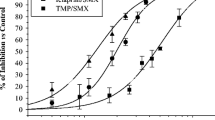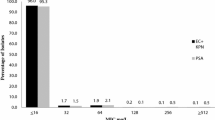Summary
Intracellular pathogens are inhibited to varying degrees, depending upon the strain of the organism and the quinolone tested. Quinolones achieve levels in the lower respiratory tract that equal or exceed serum concentrations, and they also achieve good intracellular concentrations. Experimental models of intracellular infection have demonstrated the efficacy of ciprofloxacin, difloxacin, fleroxacin, ofloxacin and pefloxacin. Animal models of experimental legionellosis have confirmedin vivo their efficacy in this field. Thus, quinolones appear to be a safe and efficacious alternative treatment in lower respiratory tract infection (LRTI) due to intracellular pathogens. Considering thein vitro and experimental studies, quinolones should play an important role in the treatment of LRTI caused by intracellular pathogens, and prospective controlled studies are strongly recommended.
Zusammenfassung
Chinolone haben je nach Art des Erregers und Art der Substanz unterschiedlich starke Hemmwirkung gegen intrazelluläre Mikroben. Wirkstoffspiegel in den tiefen Atemwegen liegen mindestens im Bereich der Serumspiegel, Chinolone erreichen außerdem brauchbare intrazelluläre Konzentrationen. In experimentellen Modellen zu intrazellulären Infektionen haben sich Ciprofloxacin, Difloxacin, Fleroxacin, Ofloxacin und Pefloxacin als wirksam erwiesen. Auch bei Tiermodellen zur Legionellose wurde die Aktivität der Chinolonein vivo belegt. Es ist folglich anzunehmen, daß Chinolone bei tiefen Atemwegsinfektionen durch intrazelluläre Erreger eine sichere und wirksame therapeutische Alternative darstellen. Aus denIn-vitro-Daten und experimentellen Studien gewonnene Erkenntnisse zur Bedeutung der Chinolone als Therapeutika tiefer Atemwegsinfektionen durch intrazelluläre Erreger sollten nun in prospektiven, kontrollierten Studien auf ihre Gültigkeit für die Klinik geprüft werden.
Similar content being viewed by others
References
Grayston, J. T., Kuo, C. C., Wang, S. P., Altman, J. P. A newChlamydia psittaci strain, TWAR, isolated in acute respiratory tract infections. N. Engl. J. Med. 315 (1986) 161–168.
Fang, G. D., Fine, M., Orloff, J., Arisumi, D., Yu, V. C., Kapoor, W., Grayston, J. T., Wang, S. P., Kohler, R., Muder, R. R., Yee, Y. C., Rihs, J. D., Vickers, B. S. New and emerging etiologies for community acquired pneumonia with implications for therapy. A prospective multicenter study of 359 cases. Medicine 69 (1990) 307–316.
Grüneberg, R. N., Felmigham, D., O'Hare, M. D., Robbins, M. J., Perry, K., Wall, R. A., Ridgway, G. L. The comparativein vitro activity of ofloxacin. J. Antimicrob. Chemother. 22 (Suppl. C) (1988) 9–19.
Garcia-de-Lomas, J., Munoz, C., Escoms, R., Valls, A., Calpagi: Activity of temafloxacin in comparison with other fluoroquinolones againstLegionella pneumophila. 3rd International Symposium on New Quinolones, Vancouver, Canada, July 12–14, 1990, Abstract no. 71.
Hardy, D. J., Swanson, R. N., Hensey, D. M., Ramer, N. R., Bower, R. R., Hanson, C. W., Chu, D. T. W., Fernandes, P. B. Comparative antibacterial activities of temafloxacin hydrochloride (A-62254) and two reference fluoroquinolones. Antimicrob. Agents Chemother. 31 (1987) 1768–1774.
Renaudin, H., Quentin, L., De Barbeyrac, B., Bebear, C. Activitéin vitro de nouvelles quinolones sur les Mycoplasmes pathogènes pour l'homme. Pathol. Biol. 36 (1988) 496–499.
Cassell, G. H., Waites, K. B., Pate, M. S., Canupp, K. C., Duffy, L. B. Comparative susceptibility ofMycoplasma pneumoniae to erythromycin, ciprofloxacin, and lomefloxacin. Diagn. Microbiol. Infect. Dis. 12 (1989) 433–435.
Waites, K. B., Cassell, G. H., Canupp, K. C., Fernandes, P. B. In vitro susceptibilities of mycoplasmas and ureaplasmas to new macrolides and Aryl fluoroquinolones. Antimicrob. Agents Chemother. 32 (1988) 1500–1502.
Osada, Y., Ogawa, H. Antimycoplasmal activity of ofloxacin. Antimicrob. Agents Chemother. 23 (1983) 509–511.
Nakamura, S., Minami, A., Katae, H., Yamagishi, S., Takase, Y., Shimizu, M. In vitro antibacterial properties of AT-2266, a new pyridonecarboxylic acid. Antimicrob. Agents Chemother. 23 (1983) 641–648.
Orfila, J., Haider, F., Eb, F. In vitro susceptibility ofChlamydia pneumoniae (strain IOL 207) against a new fluoroquinolone, sparfloxacin, compared to different other molecules. In: Program and Abstracts of the 30th Interscience Conference on Antimicrobial Agents and Chemotherapy, Atlanta, October 21–24, 1990. American Society for Microbiology, Washington D.C. 1990, Abstract no. 18.
Hyman, C. L., Roblin, P. T., Hammerschlag, M. R.: In vitro activity of sparfloxacin (C1978-AT-4140), a novel quinolone, ofloxacin and fleroxacin againstChlamydia pneumoniae. 3rd International Symposium on New Quinolones, Vancouver, Canada, July 12–14, 1990, Abstract no. 70.
Chirgwin, K., Roblin, P. M., Hammerschlag, M. R. In vitro susceptibilities ofChlamydia pneumoniae (Chlamydia sp. strain TWAR). Antimicrob. Agents Chemother. 33 (1989) 1634–1635.
Roblin, P. M., Hammerschlag, M. R. In vitro activity of sparfloxacin and two other quinolones againstChlamydia trachomatis andChlamydia pneumoniae. In: Program and Abstracts of the 30th Interscience Conference on Antimicrobial Agents and Chemotherapy, Atlanta, October 21–24, 1990. American Society for Microbiology, Washington D. C. 1990, Abstract no. 22.
Symonds, J., Javaid, A., Bone, M., Turner, A. The penetration of ofloxacin into bronchial secretions. J. Antimicrob. Chemother. 22 (Suppl. C) (1988) 91–96.
Davey, P. G., Precious, E., Winter, J. H. Bronchial penetration of ofloxacin after single and multiple oral dosage. J. Antimicrob. Chemother. 27 (1981) 335–341.
Courard, L., Fourtillan, J. B., Saux, M. C., Bryskier, A., Vincent-du-Laurier, M. Diffusion of ofloxacin into human lung tissue. Drugs 34 (Suppl. 1) (1987) 37–38.
Wijnands, W. J. A., Vree, T. B., Baars, A. M., Hafkenscheid, J. C. M., Kohler, B. E. M., Van Herwaarden, C. L. A. J. Antimicrob. Chemother. 22 (Suppl. C) (1988) 85–90.
Serour, F., Dan, M., Gorca, A., Yellin, A., Lieberman, Y., Berger, S. Penetration of ofloxacin into human lung tissue following a single oral dose of 200 milligrams. Antimicrob. Agents Chemother. 35 (1991) 380–381.
Schentag, J., Wise, R., Nix, D. E. Pharmacokinetics and tissue penetration of quinolones. In:Siporin, C., Heifetz, C. L., Domagala, J. M. (eds): The new generation of quinolones. Marcel Dekker, New York 1990, pp. 189–222.
Carlier, M. B., Sorneaux, B., Zenebergh, A., Desnottes, J. F., Tulkens, P. M. Cellular uptake, localization and activity of fluoroquinolones in infected macrophages. J. Antimicrob. Chemother. 26 (Suppl. B) (1990) 27–39.
Pocidalo, J. J. Use of fluoroquinolones for intracellular pathogens. Rev. Infect. Dis. 11 (Suppl. 5) (1989) 979–984.
Kitsukawa, K., Hara, J., Saito, A. Inhibition ofLegionella pneumophila in guinea pig peritoneal macrophages by new quinolone, macrolide and other antimicrobial agents. J. Antimicrob. Chemother. 27 (1991) 343–353.
Fitzgeorge, R. B., Featherstone, A. S. R., Baskerville, A. The effect of ofloxacin on the intracellular growth ofLegionella pneumophila in guinea pig alveolar phagocytes. J. Antimicrob. Chemother. 22 (Suppl. C) (1988) 53–57.
Rajagopalan-Levasseur, P., Dameron, G., Forgue, M. F., Pocidalo, J. J. Inhibitory and postantibacterial effect of temafloxacin on virulentLegionella pneumophia. Program and Abstracts of the 30th Interscience Conference on Antimicrobial Agents and Chemotherapy, Atlanta, October 21–24, 1990. American Society for Microbiology, Washington D.C. 1990, Abstract no. 145.
Rajagopalan-Leveasseur, P., Dournon, E., Dameron, G., Vilde, J. L., Pocidalo, J. J. Comparative postantibacterial activities of pefloxacin, ciprofloxacin, and ofloxacin against intracellular multiplication ofLegionella pneumophila serogroup 1. Antimicrob. Agents Chemother. 34 (1990) 1733–1738.
Yeaman, M. R., Roman, M. J., Baca, O. G. Antibiotic susceptibilities of twoCoxiella burnetti isolates implicated in distinct clinical syndromes. Antimicrob. Agents Chemother. 35 (1989) 1052–1057.
Raoult, D., Bres, P., Drancourt, M., Vestris, G. In vitro susceptibilities ofCoxiella burnetti, Rickettsia rickettsii andRickettsia conorii to the fluoroquinolone sparfloxacin. Antimicrob. Agents Chemother. 35 (1991) 88–91.
Yeaman, M. R., Mitscher, L. A., Baca, O. G. In vitro susceptibility ofCoxiella burnetti to antibiotics including several quinolones. Antimicrob. Agents Chemother. 31 (1987) 1079–1084.
Saito, A., Sawatari, K., Fukuda, Y., Nagasawa, M., Koga, H., Tomonaga, A., Nakazato, H., Fujita, K., Shigeno, Y., Suzuyama, Y., Yamaguchi, K., Izumikawa, K., Hara, K. Susceptibility ofLegionella pneumophila to ofloxacinin vitro and in experimental legionella pneumonia in guinea pigs. Antimicrob. Agents Chemother. 28 (1985) 15–20.
Dournon, E., Rajagopalan, P., Vilde, J. L., Pocidalo, J. J. Efficacy of pefloxacin in comparison with erythromycin in the treatment of experimental guinea pig legionellosis. J. Antimicrob. Chemother. 17 (Suppl. 1B) (1986) 41–48.
Dournon, E., Rajagopalan, P. Comparaison de l'activité de ciprofloxacine, ofloxacine et pefloxacine dans un modele animal d'infection à legionella. In:Carbon, C., Pocidalo, J. J., Cremieux, A. C. (eds.): Acquisitions Récentes sur les Nouvelles Quinolones. Arnette, Paris 1988, pp. 39–43.
Edelstein, P. H., Edelstein, M. A. C., Weidenfeld, J., Dorr, M. B. In vitro activity of sparfloxacin (CI-978; AT-4140) for clinical legionella isolates, pharmacokinetics in guinea pigs, and use to treat guinea pigs withL. pneumophila pneumonia. Antimicrob. Agents Chemother. 34 (1990) 2122–2127.
Leroy, C., Chidiac, C., Sivery, B., Senneville, E., Vincent-Du-Laurier, M., Mouton, Y. Traitement des pneumonies dues aux legionelles, mycoplasmes, chlamydiaes et rickettsies par l'ofloxacine. Pathol. Biol. 37 (1989) 1137–1140.
Mouton, Y., Beuscart, C., Leroy, O., Ajana, F., Charrel, J. Groupe multicentrique: evaluation de la ciprofloxacine versus amoxicilline plus acide clavulanique ou erythromycin pour le traitement empirique des pneumonies communautaires. Pathol. Biol. 39 (1989) 34–37.
Schonwald, S., Petricevie, I., Car, V., Soldo, I., Skerk, V.: Ciprofloxacin applied in treatment of interstitial pneumonias of infectious etiology. In:Berbaka, B. (ed.): Proceedings of the 15th International Congress of Chemotherapy, Istanbul 1987, Abstract no. 1285.
Carbon, C., Leophonte, P., andthe Frech Cooperative Study Group. A multicenter, double-blind randomized comparative study of the efficacy and safety of temafloxacin and amoxicillin in the treatment of community acquired pneumonia in hospital patients. In: Program and Abstracts of the 30th Interscience Conference on Antimicrobial Agents and Chemotherapy, Atlanta, October 21–24, 1990. American Society for Microbiology, Washington D.C. 1990, Abstract no. 782.
Wynckel, A., Toupance, O., Melin, J. P., David, C., Lavaud, S., Wong, T., Lamiable, D., Chanard, J. Traitement des légionelloses par ofloxacine chez le transplante rénal. Presse Méd. 20 (1991) 291–293.
Winter, J. H., McCartney, C., Bingham, J., Telfer, M., White, L. O., Fallon, R. J. Ciprofloxacin in the treatment of severe Legionnaire's disease. Rev. Infect. Dis. 10 (Suppl. 1) (1988) S218-S219.
Unertl, K. E., Lemhart, F., Forts, H., Vogler, G., Wilm, V., Ehret, W., Ruckdeschel, G. Brief report: ciprofloxacin in the treatment of legionellosis in criticially ill patients including those cases unresponsive to erythromycin. Am. J. Med. (Suppl. 5A) (1989) 128S-131S.
Dournon, E., Mayaud, C., Wolff, M., Schlemmer, B., Samuel, D., Sollet, J. P., Levasseur-Rajagopalan, P. Comparison of the activity of three antibiotic regimens in severe Legonnaire's disease. J. Antimicrob. Chemother. 26 (Suppl. B) (1990) 129–139.
Jambon, F., Jonquet, O., Reynes, J., Bertrand, D. Use of pefloxacin in the treatment of rickettsiosis and coxiellosis. Rev. Infect. Dis. 11 (Suppl. 5) (1989) 991.
Lipsky, B. A., Tack, K. J., Kuo, C. C., Wang, S. P., Grayston, J. T. Ofloxacin treatment ofChlamydia pneumoniae (strain TWAR) lower respiratory tract infections. Am. J. Med. 89 (1990) 722–724.
Author information
Authors and Affiliations
Rights and permissions
About this article
Cite this article
Chidiac, C., Mouton, Y. Quinolones in the treatment of lower respiratory tract infections caused by intracellular pathogens. Infection 19 (Suppl 7), S365–S371 (1991). https://doi.org/10.1007/BF01715829
Issue Date:
DOI: https://doi.org/10.1007/BF01715829




